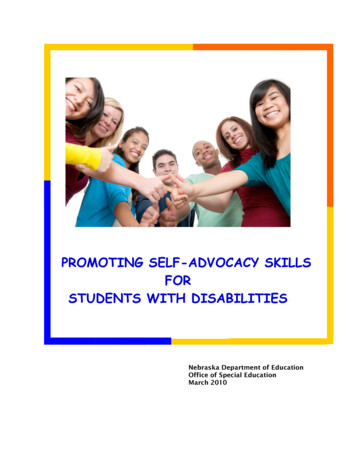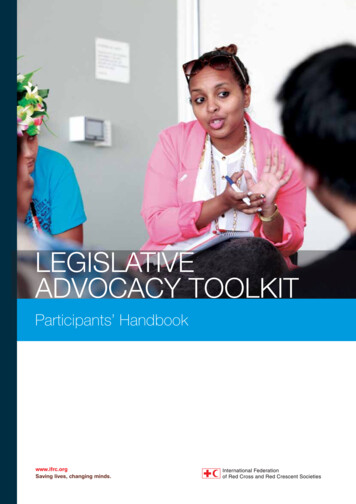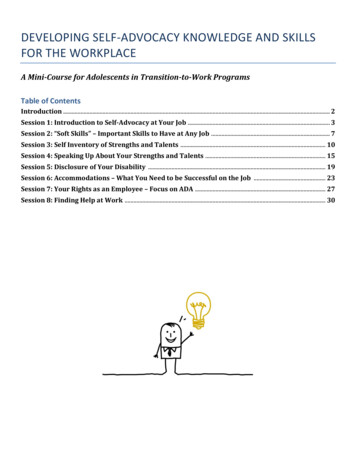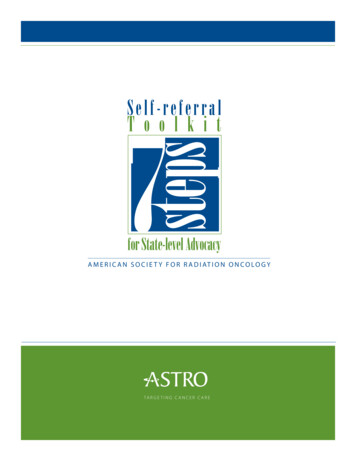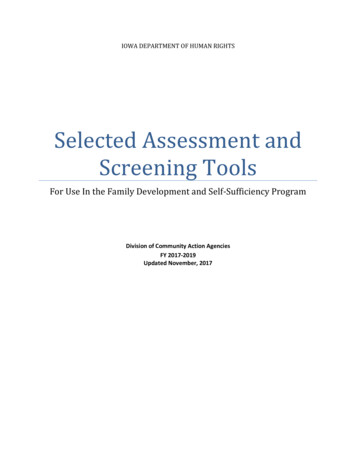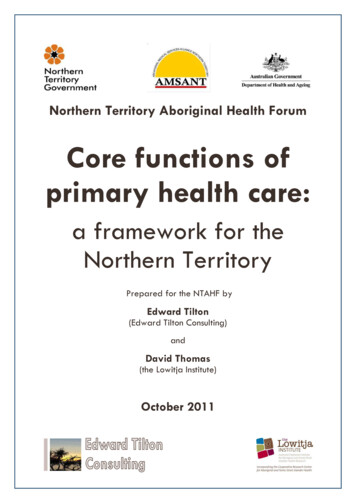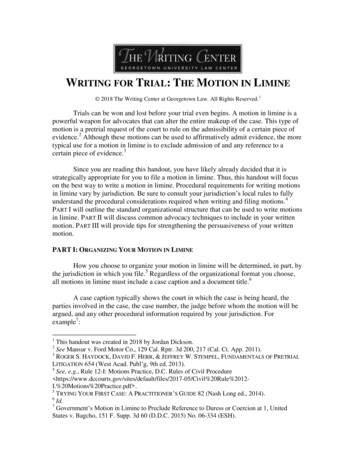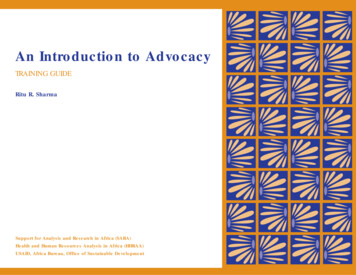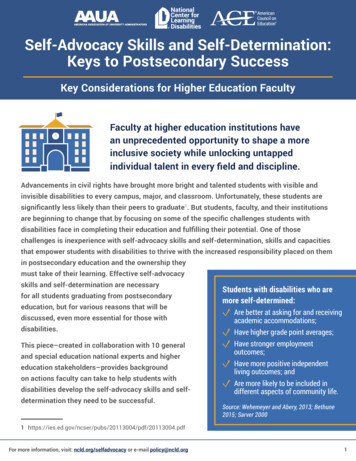
Transcription
AmericanCouncil onEducationSelf-Advocacy Skills and Self-Determination:Keys to Postsecondary SuccessKey Considerations for Higher Education FacultyFaculty at higher education institutions havean unprecedented opportunity to shape a moreinclusive society while unlocking untappedindividual talent in every field and discipline.Advancements in civil rights have brought more bright and talented students with visible andinvisible disabilities to every campus, major, and classroom. Unfortunately, these students aresignificantly less likely than their peers to graduate1. But students, faculty, and their institutionsare beginning to change that by focusing on some of the specific challenges students withdisabilities face in completing their education and fulfilling their potential. One of thosechallenges is inexperience with self-advocacy skills and self-determination, skills and capacitiesthat empower students with disabilities to thrive with the increased responsibility placed on themin postsecondary education and the ownership theymust take of their learning. Effective self-advocacyskills and self-determination are necessaryfor all students graduating from postsecondaryeducation, but for various reasons that will bediscussed, even more essential for those withdisabilities.This piece–created in collaboration with 10 generaland special education national experts and highereducation stakeholders–provides backgroundon actions faculty can take to help students withdisabilities develop the self-advocacy skills and selfdetermination they need to be successful.Students with disabilities who aremore self-determined:Are better at asking for and receivingacademic accommodations;Have higher grade point averages;Have stronger employmentoutcomes;Have more positive independentliving outcomes; andAre more likely to be included indifferent aspects of community life.Source: Wehemeyer and Abery, 2013; Bethune2015; Sarver 20001 4.pdfFor more information, visit: ncld.org/selfadvocacy or e-mail policy@ncld.org1
Self-Advocacy Skills and Self-Determination in Personalized Learning:Keys to Postsecondary Success – Key Considerations for Higher Education FacultySelf-Advocacy Skills and Self-Determination: At a GlanceSelf-advocacy skills include a personunderstanding themselves, their rights,and their needs, and communicatingthat understanding—leading to selfdetermination.Self-determination is a dispositionalcharacteristic that enables a person to actin service of freely chosen goals and makeor cause things to happen in their own life.Examples include:Examples include: Self-advocacy skills Self-awareness Goal-setting Communication Decision-making Navigating resources Problem solving Forming and nurturing relationships Self-efficacy Perspective takingUnderstanding Transition IssuesWhen students with disabilities enroll in college, they are moving from an educational environmentwhere parents, teachers, and others identify and address educational challenges on a student’sbehalf, to a setting where all of this becomes the responsibility of the student. Once enrolled incollege, these challenges might continue as each course requires students to: make judgments about and assess the nature of class content, the format of the class, andthe learning and performance expectations of the instructor; compare class expectations to their personal learning profile, which requires a strongunderstanding of their learning profile; use that analysis to make decisions about academic routines and compensatory strategiesthey will need to use in order to be successful in class; consider which accommodations are needed for each class and then actively request thoseaccommodations in every class, each semester; and follow through with those routines and strategies, utilizing other services and supports asappropriate across different courses throughout their academic career.For more information, visit: ncld.org/selfadvocacy or e-mail policy@ncld.org2
Self-Advocacy Skills and Self-Determination in Personalized Learning:Keys to Postsecondary Success – Key Considerations for Higher Education FacultyFor students who are entering higher education,these challenges arise at the same time theyare exploring and navigating an entirely neweducational environment and often living ontheir own for the first time. If a student enrollsin a course where there is a mismatch betweenthe instructor’s teaching style, understandingof disabilities, willingness to serve studentswith disabilities, and the student’s learningstrengths and needs, their challenges may beconsiderable. Moreover, many disabilities are“invisible” (e.g. learning and attention issueslike dyslexia and ADHD), so faculty and staffmay be unable to immediately identify a needfor support.Misunderstandings and myths about learningdifferences may result in assumptions that some student behaviors are a result of a lack ofmotivation or entitlement, leaving a missed opportunity to equip students to fully utilize the personalroutines and campus supports needed for learning and success.As a faculty member, you can take high-impact actions to contribute to your discipline and help yourstudents succeed and achieve their fullest potential by understanding their needs, recognizing theimportance of self-advocacy skills and self-determination, advocating for those needs within yourdepartment, and proactively supporting them to use these skills and capacities to succeed in yourclassroom. Both within your department and within your classroom, you can take proactive steps todispel and counter 6 myths your colleagues or your students (including internalized myths studentswith disabilities have about themselves) have about individuals with disabilities.For more information, visit: ncld.org/selfadvocacy or e-mail policy@ncld.org3
Self-Advocacy Skills and Self-Determination in Personalized Learning:Keys to Postsecondary Success – Key Considerations for Higher Education FacultySIX MYTHS ABOUT STUDENTS WITH DISABILITIES AND HOW TO ADDRESS THEM1 MYTH: The presence of a disability--whether physical or “invisible,” such as learning disabilitiesand Attention Deficit Hyperactivity Disorder (LD/ADHD)--implies that a student is not capable ofexcelling in college coursework.ACTION: Students may need accommodations that enable them to access information or expresswhat they are learning in different ways. They may also use different study routines to applycontent-related understanding outside of the classroom. That said, they are in college because theyhave demonstrated potential for postsecondary success – similar to students without disabilities.Faculty members can be instrumental in supporting them to effectively advocate for their rights,needs, interests, and learning potential.2 MYTH: Students regularly use their disability as a “crutch” and have become entitled by all thesupports received in the K-12 setting.ACTION: Leaving an environment with a high amount of external support and structure and enteringone that demands much more independence and confidence may be challenging, but that does notimply a lack of motivation to make that transition. What might look like entitlement might actuallybe a student learning how to navigate this adjustment period. Faculty members can encouragestudents to use supports available to them. Moreover, if faculty are willing to see their course fromthe eyes of the student, they can be instrumental in collaborating with the student to set and reachhigh expectations in the course.3 MYTH: Professors who are experts in the subject they teach and who receive positive reviews ontheir teaching style should not change their instructional methods as students need to learn toadapt and develop quality study habits to be successful.ACTION: Your colleagues can recognize that what is typically taken for granted (e.g., reading atextbook) as an easy task for many students can be very tedious, time-consuming, and exhaustingfor some students with disabilities. Some might incorrectly perceive that a student who is lookingfor alternate ways to learn something is lazy or lacking motivation – when in fact the exact oppositemay be true. For example, if a student looks for alternative resources to the textbook, they maybe trying to find resources that support their processing needs so they can more fully understandthe concepts – not to get out of the assigned readings. If a student asks for a PowerPoint file inadvance, they may be planning to use it for pre-studying and in-class note taking – not to find away to skip class. Finding and developing resources that depict, engage, and enable students todemonstrate learning in multiple ways—the essential tenets of Universal Design for Learning—canbe a game-changer for some students while being helpful to all.For more information, visit: ncld.org/selfadvocacy or e-mail policy@ncld.org4
Self-Advocacy Skills and Self-Determination in Personalized Learning:Keys to Postsecondary Success – Key Considerations for Higher Education Faculty4 MYTH: “Teaching to the middle” will at least reach the majority of students in a classroom.ACTION: You can embrace the notion that everyone does not learn the same way you do—andeveryone does not learn the way you teach. That does not reflect negatively on your teachingstyle. To the contrary, we all have different learning profiles, needs, interests, and strengths, andwe are likely to teach in the same way we learn personally. Simulations, such as Understood.org’sThrough Your Child’s Eyes, may help you understand how a struggling student sees the world andenvision the impact of your instructional decisions on the learning of students with certain learningcharacteristics. You can then think about how to create classroom environments that bring out thebest in students with a variety of learning profiles.5 MYTH: Designing lessons to reach the more diverse learners in a class will take a tremendousamount of time and is not possible in an already packed schedule.ACTION: When you infuse research-based teaching practices, such as principles of UniversalDesign for Learning (UDL), in designing courses and supporting effective instruction, you teach toall students, rather than teaching to the “average” learner – something that may save time in thelong run and will enable you to keep expectations high for all students. Again, this can be a gamechanger for students with disabilities while being helpful to all students. It can be surprising howsmall adjustments or additions to a course can make a big difference. Moreover, making theseadjustments across your department can help you know that you are not unintentionally creatingbarriers to learning and expressions of learning that frustrate achievement of the high academicstandards you seek to maintain.6 MYTH: Variety in assessment methods will make very little difference on student performance. It’sall about how hard the students work and study.ACTION: Again, faculty can consider UDL in planning for assessments and how success ismeasured. Supporting authentic, flexible, and multiple ways to demonstrate understanding isbetter for all students. It’s important to explore options for evaluating and re-designing assessmentto avoid raising unintentional barriers for students with disabilities. Such options may include acampus professional development office, teaching and learning center, etc. Keep the challengewhere it should be – in learning complex and high-quality content within your field. By removingbarriers in assessment techniques--including both formative and summative assessments–thathave nothing to do with students’ understanding of the subject matter, you can keep performanceexpectations high and empower students to show you what they have learned from your teaching.For more information, visit: ncld.org/selfadvocacy or e-mail policy@ncld.org5
Self-Advocacy Skills and Self-Determination in Personalized Learning:Keys to Postsecondary Success – Key Considerations for Higher Education FacultyRECOGNIZING DIFFERENCE, TRANSFORMING A FIELDPete Denman credits much of his success to his capacity to learn from his own struggles andrecreate his life. Known best for being the lead designer at Intel for famed physicist StephenHawking’s speech software, Denman could relate to Hawking’s circumstances more thanmost. Denman persistently struggled in school, despite tests showing above average IQ.What those IQ tests failed to diagnose was Denman’s dyslexia.At the age of 20, Denman was left quadriplegic following a diving accident. The combinationof his visible and invisible disabilities plus the perception that others had of his conditionscaused him to struggle with depression. It wasn’t until he enrolled at Portland CommunityCollege that Denman began to hit academic strides. For the first time in his life, he cameto realize that he was smart and didn’t have to settle for less than his biggest dreams. Heeventually transferred to Portland State University and graduated in 1998 with a Bachelor ofScience Degree in Design and Visual Communications.Denman’s success has come not despite, but because of his disabilities. He credits hisdyslexia for his capacity to be more social and believes his disabilities gave him the ability tolook at the world in new ways and inspired his innovative and life-changing work. He is alsoquick to note that his career and life have been shaped by positive and negative experiences-- by individuals in college who dismissed him, as well as those who engaged and empoweredhim to become the self-possessed thinker and leader he is today.Pete Denman has done more than give voice toone of the most revered minds of our time. Hehas given voice to a new generation of thinkersand leaders who believe that, with the rightsupport, their identity and disability can fuelrather than inhibit their education, career, andlives. His advice for postsecondary faculty whoteach students with disabilities today is, “A rampis an obvious accommodation to give accessto anyone who is in a wheelchair. But for peoplewho learn differently, it’s not obvious that asmall tool or accommodation can be that rampthat will open opportunities. These people whoprocess differently are often our most creativethinkers because of this difference, not despiteit. We need more of these kind of thinkers.”For more information, visit: ncld.org/selfadvocacy or e-mail policy@ncld.org6
college, these challenges might continue as each course requires students to: make judgments about and assess the nature of class content, the format of the class, and the learning and performance expectations of the instructor; compare class expectations to their personal
